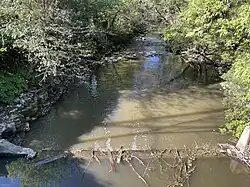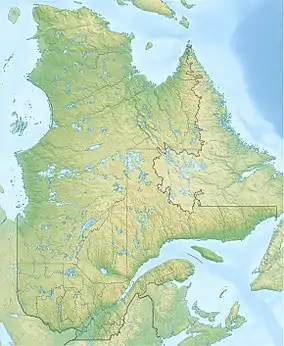Niagarette River
The Niagarette River is a stream flowing in the municipalities of Saint-Ubalde, Saint-Thuribe and Saint-Casimir, in the Portneuf Regional County Municipality, in the administrative region of Capitale-Nationale, in Quebec, in Canada.
| Niagarette River | |
|---|---|
 Mountain Boulevard (Quebec Route 363), Saint-Casimir | |
 | |
| Location | |
| Country | Canada |
| Province | Quebec |
| Region administrative | Capitale-Nationale, Mauricie |
| Regional County Municipality | Portneuf Regional County Municipality |
| Municipalities | Saint-Ubalde, Saint-Thuribe, Saint-Casimir |
| Physical characteristics | |
| Source | Little unidentified lake |
| • location | Saint-Ubalde, MRC Portneuf Regional County Municipality |
| • coordinates | 46°44′15″N 72°12′48″W |
| • elevation | 138 m (453 ft) |
| Mouth | Blanche River |
• location | Saint-Casimir |
• coordinates | 46°39′08″N 72°08′28″W |
• elevation | 30 m (98 ft) |
| Length | 20.3 km (12.6 mi) |
| Discharge | |
| • location | Saint-Casimir |
| Basin features | |
| Tributaries | |
| • left | Décharge du lac Saint-Léon |
| • right | (Upward from the mouth) Petite rivière Niagarette, rivière du Rang Saint-David. |
The first segment of 5.4 kilometres (3.4 mi) of the course of the Niagarette river is forest area; the rest of its route flows through an agricultural environment, while passing south of the village of Saint-Casimir at the end of the route.[1]
The surface of the Niagarette River (except the rapids zones) is generally frozen from the beginning of December to the end of March, but the safe circulation on the ice is generally made from the end of December to the beginning of March.
Geography
The watershed of the Niagarette river covers an area of 53.85 square kilometres (20.79 sq mi).[2]
The Niagarette river takes its source from a small unidentified lake (altitude of 138 metres (453 ft)), located in a forest area in the eastern part of the municipality of Saint-Ubalde. This lake is located 4.8 kilometres (3.0 mi) east of the village center of Saint-Ubalde and 10.8 kilometres (6.7 mi) northwest of the confluence of the Niagarette River and the Sainte-Anne River.
From its source, the course of the Niagarette river flows over 20.3 kilometres (12.6 mi) with a drop of 108 metres (354 ft). It receives the waters of its main tributary, the Petite rivière Niagarette, at 1.6 kilometres (0.99 mi)[3] from its mouth. The average slope of the Niagarette river is 6.6 metres per kilometre (35 ft/mi). Besides the first five kilometers upstream which have a slope of 1.42%, the slope of the rest of the river is low with 3.8 metres per kilometre (20 ft/mi).
The Niagarette river flows according to the following segments:
- 1.7 kilometres (1.1 mi) to the west;
- 3.7 kilometres (2.3 mi) east to the limit of the forest area;
- 4.1 kilometres (2.5 mi) south-east to the confluence of the Rang Saint-David River (coming from the west);
- 3.5 kilometres (2.2 mi) towards the south-east, meandering in an agricultural area to the chemin du 3e rang in Saint-Thuribe;
- 3.7 kilometres (2.3 mi) towards the south-east by meandering in agricultural area to the railway bridge;
- 2.0 kilometres (1.2 mi) to the southeast by winding through an agricultural zone and cutting the route 363 until the confluence of the Petite rivière Niagarette (coming from the west);
- 1.6 kilometres (0.99 mi) to the east, forming a few loops passing south of the village of Saint-Casimir, to its mouth.
After cutting the route 354 which runs along the northwest shore of the Sainte-Anne river, the Niagarette river flows onto the shore west of the latter at 0.4 kilometres (0.25 mi) south of the village bridge of Saint-Casimir. From there, the current descends on 0.9 kilometres (0.56 mi) southwards following the course of the Sainte-Anne River, to the northwest bank of St. Lawrence River.
Agriculture covers 60% of the river basin. This is the Sainte-Anne River sub-basin whose land use is most agricultural.[4]
Fauna
Fish species found in the Niagarette River[5]
Dard barré - Épinoche à cinq épines - Lamproie de l'Est - Méné à museau arrondi - Méné à nageoires rouges - Méné bec-de-lièvre - Méné paille - Meunier noir - Mulet à cornes - Mulet perlé - Naseux des rapides - Omisco - Raseux-de-terre noirs - mulet perlé. Fish photos some whit English translation:[6]
The majority of fish species were sampled by the Corporation d'Aménagement et de Protection de la Sainte-Anne in 2002 (CAPSA).
History
Two major floods have been reported in the history of the Niagarette River, in 1939[7] and in 1973,[8] On August 10, 1939, the erosion of the banks of the Niagarette river had damaged the low walls of cement and the rip-rap of the banks near the buildings south of the village of Saint-Casimir. This sudden flood also damaged the route 363 and swept away the residences of the families of Réjean Lépine and Rolland Duchesneau, located near the course of the river as well as part of their respective terrain. The houses of MM. Victorin Naud and Lévis Tessier were also damaged.[9]
On October 29, 1986, the Gazette officielle du Québec published decree 1512–86 at the request of the municipality of Saint-Casimir for the reconstruction of a dam for the purpose of aqueduct on the bed of the Niagarette river.[10]
In 1998, the municipality of Saint-Casimir had a project to divert the Niagarette river by giving it a more rectilinear route in order to resolve its flooding problems. The Niagarette river then had a meander more than 200 meters long, suitable for the formation of ice jams during the snowmelt.[11]
Toponymy
The spelling of the toponym occasionally took the form "Naigarette River" dating back to the end of the 19th century and perhaps even before. This toponym could be explained as being a diminutive of the famous Niagara Falls. The term Iroquois niagara means "to resonate", "to make noise".[12]
The toponym "Niagarette River" was formalized on August 17, 1978, at the Place Names Bank of the Commission de toponymie du Québec.
Photos
Niagarette River in Saint-Casimir Municipality
 Rue Tessier (Quebec Route 354) from bridge P-16132[13]
Rue Tessier (Quebec Route 354) from bridge P-16132[13] Rue Tessier (Quebec Route 354), Sainte-Anne River and mouth of the Niagarette P-16132
Rue Tessier (Quebec Route 354), Sainte-Anne River and mouth of the Niagarette P-16132 Mountain Boulevard (Quebec Route 363)
Mountain Boulevard (Quebec Route 363) Godin Street from P-06074
Godin Street from P-06074
References
- "Niagarette River map" (in French). Wikipédia.org. Retrieved 21 September 2021.
- "Rivière Niagarette". CAPSA - territoire (in French). Corporation d'aménagement et de protection de la rivière Sainte-Anne (CAPSA. Retrieved 18 September 2023.
- "The Atlas of Canada - Toporama". Natural Resources Canada. Government of Canada. 2023-09-18. Retrieved 21 September 2023.
- "State of the aquatic ecosystem of the Sainte-Anne River watershed" (pdf) (in French). Ministère du Développement durable, de l'Environnement et des Parcs Quebec. 2004–2006. p. 2. Retrieved 21 September 2023.
- Avery Annabelle. "Des actions pour la faune en milieu agricole". Bibliothèque et Archives nationales du Québec (BAnQ) (in French). Fondation de la faune du Québec. Retrieved 2023-09-22.
- "Fish species found in the Niagarette River" (in French). Ministère du Développement durable, de l'Environnement et des Parcs Land use and description Quebec. 2006. Retrieved 21 September 2023.
- "Rivière Niagarette: érosion à Saint-Casimir". BAnQ - Fonds Ministère de l'Environnement et de la Lutte contre les changements climatiques. 1939. Retrieved 2023-09-22.
- Genois, Gaétan (10 August 2023). "The flood at Saint-Casimir, August 10, 1973" (in French). Le Courrier de Portneuf. Retrieved 23 September 2023.
- Article "À Saint-Casimir, la solidarité alimente l'espoir" (English: At Saint-Casimir, solidarity fuels hope), by Roger Noreau, Journal Le Nouvelliste, August 14, 1973, p. 11(in French)
- Gazette officielle du Québec - Decree 1512-86 of October 8, 1986 - Reconstruction of the dam the Niagarette River
- Articles "Floods - Saint-Casimir wants to divert the Niagarette", by Michel Godin, Journal Le Nouvelliste, March 30, 1998, p. A5.
- "Rivière Niagarette". Commission de toponymie Quebec (in French). Government of Quebec. 2023-09-22. Retrieved 2023-09-22.
- "Inventory and inspection of structures". Ministère des Transport et de la Mobilité durable Quebec (in French). Government of Quebec. 2023-09-22. Retrieved 2023-09-22.
External links
- About CAPSA one of 40 watershed organizations recognized by the Government of Quebec and an NPOL, publisher: Government of Quebec (French). ). Retrieved 21 September 2023
- "Portrait hydrologique et multi-ressources du bassin versant de la rivière Sainte-Anne" (PDF) (in French). Corporation d'aménagement et de protection de la Sainte-Anne (CAPSA). p. 137. Retrieved 18 September 2023.